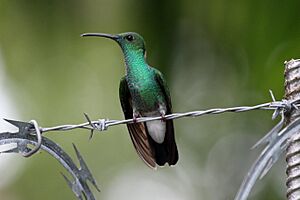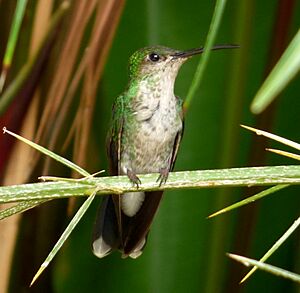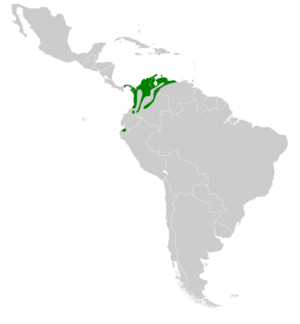White-vented plumeleteer facts for kids
Quick facts for kids White-vented plumeleteer |
|
|---|---|
 |
|
| Male | |
 |
|
| Female | |
| Conservation status | |
| Scientific classification | |
 |
|
| Range of C. buffonii |
The white-vented plumeleteer (Chalybura buffonii) is a type of hummingbird. It belongs to a group of hummingbirds called "emeralds." This bird is known for its bright colors and fast flying.
You can find the white-vented plumeleteer in several countries. These include Colombia, Ecuador, Panama, Peru, and Venezuela.
Contents
Different Types of White-Vented Plumeleteers
Scientists group animals into different types. Most experts agree there are five main types, or subspecies, of the white-vented plumeleteer:
- C. b. micans
- C. b. buffonii
- C. b. aeneicauda
- C. b. caeruleogaster
- C. b. intermedia
Sometimes, scientists have different ideas about these groups. For example, some think C. b. intermedia is a subspecies of a different bird. This other bird is called the bronze-tailed plumeleteer. Also, C. b. caeruleogaster and C. b. intermedia have sometimes been thought of as their own separate species.
What Does This Hummingbird Look Like?
The white-vented plumeleteer is a medium-sized hummingbird. It is about 10.5 to 12 centimeters (4 to 4.7 inches) long. Males usually weigh between 6 and 7.3 grams. Females are a bit lighter, weighing from 5.9 to 7.9 grams.
Most of these birds have a black beak and black feet. However, the intermedia subspecies is different. It has a pinkish base on its beak and light pink or red feet.
Male and Female Differences
Male white-vented plumeleteers are mostly dark metallic green on their upper parts. Their head feathers can look a bit bronzy. Their upper chest is bluish, and their lower chest is bright metallic green. The lower belly is whitish, and the feathers under their tail are long and white. Their tail is blue-black.
Female white-vented plumeleteers are a lighter metallic green on top. Their underside is gray with green speckles on the sides. Their tail looks like the males' but has dull gray tips on the outer feathers.
Subspecies Colors
Each subspecies has slight color differences:
- C. b. micans is larger than the main type. Its central tail feathers are a deeper blue. Females have clearer gray undersides.
- C. b. aeneicauda males are more golden-green below. Their central tail feathers are bright bronze-green or copper-bronze. Females have light gray undersides with few green spots.
- C. b. caeruleogaster is the largest subspecies. Males have a bluish-green throat and belly, and a blue chest. Females have gray undersides with no spots.
- C. b. intermedia males have a greenish-blue chest, a gray belly, and a dark blue tail.
Where Do White-Vented Plumeleteers Live?
These hummingbirds live in different areas depending on their subspecies:
- C. b. micans lives in central and eastern Panama. It also lives in western Colombia and parts of Colombia's river valleys.
- C. b. buffonii is found from central Colombia east into northwestern Venezuela.
- C. b. aeneicauda lives in Colombia's lower Magdalena valley and Santa Marta region. It also extends east into western and north-central Venezuela.
- C. b. caeruleogaster lives on the eastern side of Colombia's Eastern Andes mountains.
- C. b. intermedia is found in southwestern Ecuador and northwestern Peru.
White-vented plumeleteers live in many different places. These include the edges and insides of dry, moist, and wet forests. They also live in open woodlands, new forests, and bushy areas. They can live from sea level up to 2,000 meters (about 6,500 feet) high.
How White-Vented Plumeleteers Behave
Movement
These hummingbirds do not travel long distances. They stay in the same area all year round.
Feeding Habits
The white-vented plumeleteer eats nectar from many different kinds of flowers. They find food from the ground level up to the tops of trees. They often visit a set path of flowers, like a route. They also protect areas with lots of flowers from other birds.
Besides nectar, they also eat small arthropods (like insects or spiders). They catch these tiny creatures by flying out from a branch. They also hover to pick bugs off plants or spider webs.
Life Cycle and Reproduction
The breeding season for these hummingbirds changes depending on where they live. For example, they breed in September in Panama. In other areas, it can be from February to August or June to November. Some might even breed all year in parts of Venezuela.
Their nest is a cup shape made of soft plant material. They use spiderwebs to hold it together. Moss and lichen are often on the outside of the nest. Nests have been found on tree branches about 2.5 meters (8 feet) above the ground. One nest that was watched closely had two eggs. The single baby bird that hatched left the nest after 21 days.
Vocalization
Scientists have not fully described the white-vented plumeleteer's song in words. However, they are known to make "chip" sounds while they are looking for food.
Status of the White-Vented Plumeleteer
The IUCN (International Union for Conservation of Nature) has said the white-vented plumeleteer is a species of "least concern." This means they are not currently in danger of disappearing.
They have a large area where they live. There are at least 500,000 adult birds, but this number might be going down. No major threats have been found for them right now. They are considered common in most places. They also seem to be able to live even if their habitat changes a bit. However, the forests where the C. b. caeruleogaster subspecies lives are being cut down a lot.


